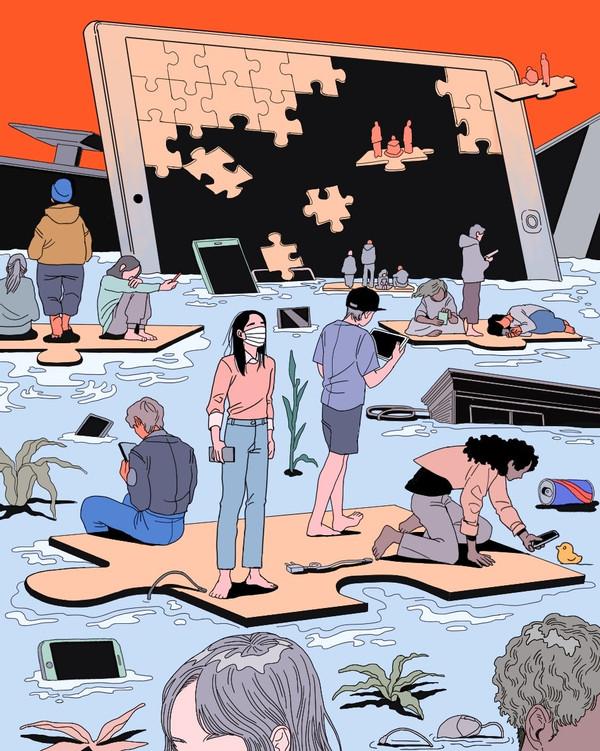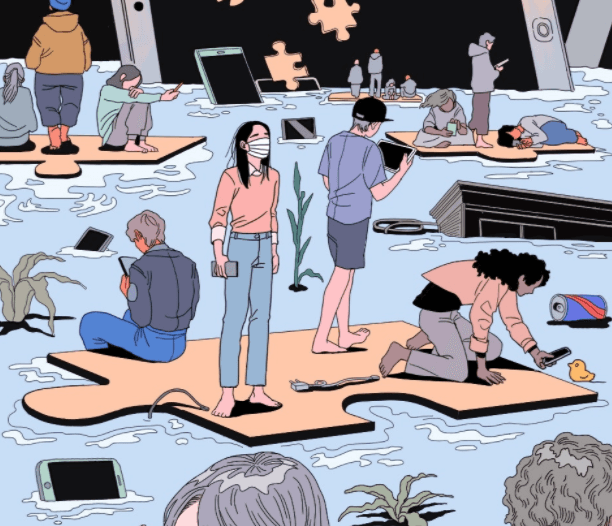The Antidote To Digital Disconnectivity | NOEMA
Curated from: noemamag.com
Ideas, facts & insights covering these topics:
10 ideas
·1K reads
9
Explore the World's Best Ideas
Join today and uncover 100+ curated journeys from 50+ topics. Unlock access to our mobile app with extensive features.
Paradoxes
Community requires ritual and narrative.
The paradoxes of the information age make the mind swim. The more we are informed, the more we are disoriented. The more we connect, the more we are divided. The more new content there is to consume, the less we are ever satisfied. The faster the network speed, the shorter our attention span becomes.
We need a philosopher to sort it all out. Fortunately, such a thinker for our times has arrived on the scene: Byung-Chul Han, author of such penetrating meditations on digital society as “The Burnout Society” and “The Disappearance of Rituals.”
33
199 reads
Corrosive Information
“Bits of information provide neither meaning nor orientation,” Han observes in an interview with Noema this week. “They do not congeal into a narrative. They are purely additive. From a certain point onwards, they no longer inform — they deform.”
The way information now courses through society is also corrosive.
“Digital communication redirects the flows of communication. Information is spread without forming a public sphere,” the South Korea-born German philosopher says. “It is produced in private spaces and distributed to private spaces.
31
155 reads
Atomization
The web does not create a public.” On the contrary: “The informatization of reality leads to its atomization — separated spheres of what is thought to be true.”
Instead of the basis for a common narrative, truth becomes a subjective projection of those isolated from each other.
He goes on: “This has highly deleterious consequences for the democratic process. Social media intensify this kind of communication without community. You cannot forge a public sphere out of influencers and followers.”
31
130 reads
Erosion
As Han sees it, this fragmentary character of peer-to-peer communication both coincides with and fuels the erosion of those pillars of cohesion that once held communities together.
“The inwardly turned, narcissistic ego with purely subjective access to the world is not the cause of social disintegration but the result of a fateful process at the objective level. Everything that binds and connects is disappearing. There are hardly any shared values or symbols, no common narratives that unite people.”
30
97 reads
Stability
For Han, the traditional rituals that once provided a founding orientation for society were discarded by modernity as hackneyed customs of the outmoded past.
The past cannot be revived, but, as Han says, “What we need most are temporal structures that stabilize life. When everything is short-term, life loses all stability. Stability comes over long stretches of time: faithfulness, bonds, integrity, commitment, promises, trust. These are the social practices that hold a community together. They all have a ritual character.
34
82 reads
Ritual forms
They all require a lot of time. Today’s terror of short-termism — which, with fatal consequences, we mistake for freedom — destroys the practices that require time. To combat this terror, we need a very different temporal politics.”
Han looks to culture for the recovery of a sense of stability amid the onslaught of accelerated digital time.
“Cultural events such as theater, dance and even football have a ritual character. The only way in which we can revitalize community is through ritual forms. Today, culture is held together solely by instrumental and economic relations.
31
66 reads
Tim Gorichanaz
But that does not found communities — it isolates people. Art, in particular, should play a central role in the revitalization of rituals.”
Also writing in Noema, Tim Gorichanaz scores the dichotomous binary thinking encoded in digital communication as displacing our cultural capacity for contextual narrative, reflection and empathy when processing information.
We are so lacking in these attributes nowadays, he notes, that we tear down potential heroes who would weave moral fiber into society through emulation before we can even stand them up.
32
68 reads
“Slow Technology”
While the philosopher Han looks to art to recover a culture of cohesion, Gorichanaz sees some promise in what he calls “slow technology.”
“The digital revolution has shaken up our understanding of narrative, but there are new technologies that could help us recontextualize rather than decontextualize,” he writes.
“Are.na, for example, is an online platform for bookmarking items you find online and making connections across them. It describes itself as ‘Tumblr meets Wikipedia.’ Users construct ‘channels’ by adding things they find — links, text, video — allowing narratives to emerge.
34
68 reads
The Need of Context
Roam Research is a similar platform, a notetaking app that allows complex interlinking between pieces of content, creating dynamic networks and hierarchies of information.”
He concludes: “Societally, we need such technologies for the public, perhaps built into the social media platforms that have become the de-facto online living rooms for so many of us. We need context for the torrent of information sent our way.”
31
67 reads
The Antidote
Ritual. Narrative. Context. Temporal stability. In short, everything missing from the connected isolation of digital disconnectivity is the antidote to its corrosion of community.
The recovery of culture from the grip of subjectivism and its dispersion into disparate bits of information is the daunting challenge of art — and technology — in the next turn of the digital age.
Nathan Gardels is the editor-in-chief of Noema Magazine.
33
71 reads
IDEAS CURATED BY
Antonio Gallo's ideas are part of this journey:
Learn more about communication with this collection
Strategies for promoting inclusivity
How to address unconscious bias
How to create a diverse and inclusive workplace
Related collections
Similar ideas
24 ideas
All That Is Solid Melts Into Information | NOEMA
noemamag.com
4 ideas
10 ideas
Confucianism
education.nationalgeographic.org
Read & Learn
20x Faster
without
deepstash
with
deepstash
with
deepstash
Personalized microlearning
—
100+ Learning Journeys
—
Access to 200,000+ ideas
—
Access to the mobile app
—
Unlimited idea saving
—
—
Unlimited history
—
—
Unlimited listening to ideas
—
—
Downloading & offline access
—
—
Supercharge your mind with one idea per day
Enter your email and spend 1 minute every day to learn something new.
I agree to receive email updates

